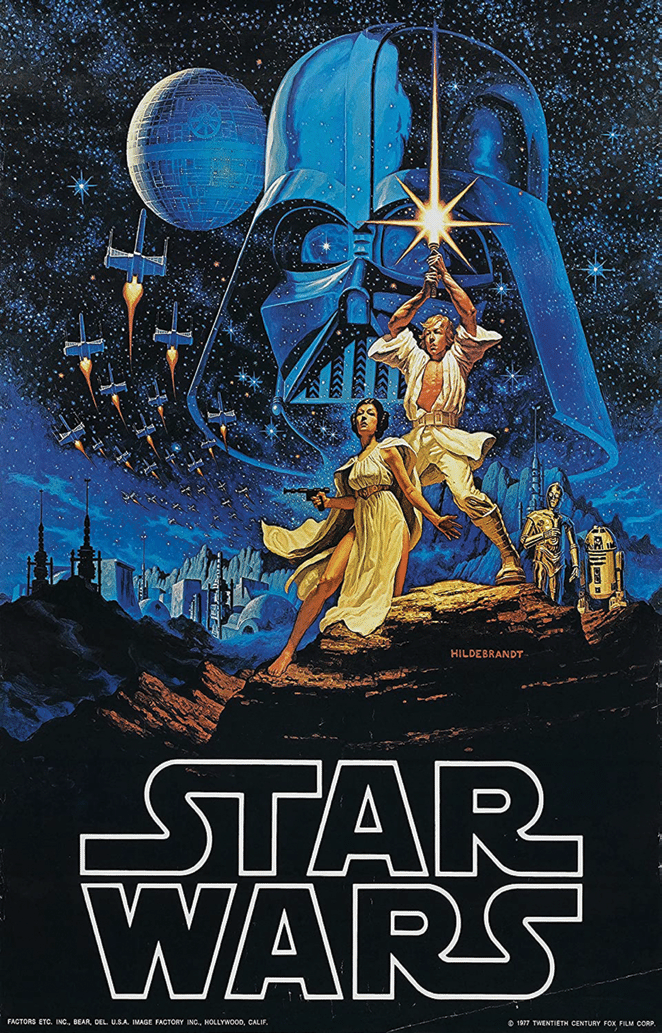- Movie Review: Fall (2022)
- Movie Review: Snowpiercer (2013)
- Movie Review: 2001: A Space Odyssey (1968)
- Movie Review: Blade Runner (1982)
- Movie Review: Star Wars: Episode IV – A New Hope (1977)
Overview
Summary
"Star Wars: Episode IV - A New Hope" is a timeless masterpiece that not only revolutionized the science fiction genre but also left an indelible mark on the entire film industry. Released in 1977, it is the film that started it all, launching the iconic Star Wars franchise and forever changing the way we perceive and experience science fiction on the big screen.
Review
George Lucas, the visionary director and creator of this epic space opera, transported audiences to a galaxy far, far away, introducing us to a richly detailed and immersive universe filled with memorable characters, breathtaking landscapes, and groundbreaking special effects. The film’s influence on popular culture is immeasurable, and its enduring legacy is a testament to its cinematic brilliance.
The film’s plot follows the young farm boy Luke Skywalker (Mark Hamill), who embarks on a heroic journey after discovering his connection to the mystical Force and learning about his destiny as a Jedi Knight. He joins forces with the wise and enigmatic Obi-Wan Kenobi (Alec Guinness) and the charismatic smuggler Han Solo (Harrison Ford) to rescue Princess Leia (Carrie Fisher) from the clutches of the evil Galactic Empire, led by the menacing Darth Vader (David Prowse, voiced by James Earl Jones). Their mission is to deliver stolen plans for the Empire’s ultimate weapon, the Death Star, which has the power to destroy entire planets.
What sets “A New Hope” apart from other science fiction films is its ability to balance the grandeur of intergalactic conflict with the relatable struggles of its characters. Luke Skywalker’s journey from a simple farm boy to a hero of the Rebellion is a classic hero’s arc that resonates with audiences of all ages. His development is complemented by the wise guidance of Obi-Wan Kenobi, whose words of wisdom continue to inspire generations.
The film’s villains are equally iconic. Darth Vader is one of cinema’s most memorable and menacing antagonists, with his deep voice, imposing presence, and mastery of the dark side of the Force. The Empire’s cold and calculated ruthlessness is the perfect foil to the Rebellion’s plucky and diverse cast of characters, making the conflict at the heart of the story both engaging and emotionally charged.
“A New Hope” stands out for its groundbreaking special effects, especially considering it was released in 1977. The practical and visual effects used in the film were ahead of their time, from the realistic space battles to the lifelike creatures like the Wookiee Chewbacca and the droids R2-D2 and C-3PO. John Williams’ iconic score further elevates the film, creating an unforgettable and emotive backdrop to the story.
The film’s themes of hope, heroism, and the battle between good and evil are universal and resonate deeply with audiences. The Rebel Alliance’s struggle against the oppressive Empire serves as an allegory for the timeless fight against tyranny and injustice. These themes continue to be relevant, making “A New Hope” a film that transcends its genre.
In conclusion, “Star Wars: Episode IV – A New Hope” is a cinematic masterpiece that has stood the test of time. Its blend of captivating storytelling, groundbreaking special effects, and unforgettable characters has solidified its place in the annals of film history. This epic space opera is a must-see for anyone interested in the art of filmmaking and a touchstone for science fiction enthusiasts. Whether you’re a lifelong fan or a newcomer to the Star Wars universe, this film offers an experience that is both timeless and full of hope.
Producer: Gary Kurtz
Screenplay: George Lucas
Story: George Lucas
Music: John Williams
Cinematography: Gilbert Taylor
Editor: Paul Hirsch, Marcia Lucas, Richard Chew
Production Designer: John Barry
Art Direction: Leslie Dilley, Roger Christian, Norman Reynolds
Set Decoration: Roger Christian
Costume Design: John Mollo
Makeup and Hair: Stuart Freeborn
Sound: Derek Ball, Ben Burtt
Special Effects: John Stears
Visual Effects: John Dykstra
Stunt Coordinator: Peter Diamond
Fight Choreography: Bob Anderson
STORY
The film opens with the iconic text crawl, informing us that the galaxy is in a state of civil war. The evil Galactic Empire, led by the tyrannical Emperor Palpatine and his enforcer, Darth Vader, is seeking to crush the Rebel Alliance, a group of freedom fighters opposing their rule.
The story kicks off on the desert planet Tatooine, where we meet Luke Skywalker, a young farm boy who dreams of adventure among the stars. Luke is living with his Aunt Beru and Uncle Owen on their moisture farm, but he longs for a life beyond the confines of Tatooine. His destiny is set in motion when he comes into possession of two droids: the protocol droid C-3PO and the astromech droid R2-D2. These droids carry a message for the former owner of their current location, the reclusive Jedi Knight Obi-Wan Kenobi.
As Luke learns more about the droids’ mission and their connection to Princess Leia Organa, a leader of the Rebel Alliance, he becomes entangled in the conflict between the Empire and the Rebellion. With the help of the wise Obi-Wan Kenobi, who reveals that he was once a Jedi Knight, Luke decides to leave Tatooine and join the fight against the Empire. This decision sets the stage for the hero’s journey that follows.
Luke, Obi-Wan, and the droids set out on their quest to deliver the stolen Death Star plans, which hold the key to the Empire’s ultimate weapon, the Death Star. Along the way, they encounter Han Solo, a charming and roguish smuggler, and his co-pilot and friend, Chewbacca, the Wookiee. Han Solo initially refuses to get involved with the Rebellion, but the promise of a substantial reward changes his mind, and he agrees to transport Luke and Obi-Wan to the planet Alderaan.
Meanwhile, we learn more about the sinister intentions of the Empire. Darth Vader, a Sith Lord with powerful command over the Force, is tasked with locating the Death Star plans and destroying the Rebellion. He interrogates Princess Leia aboard the Death Star, but she resists revealing the Rebel base’s location.
The heroes’ journey takes them to the planet Alderaan, only to find it destroyed by the Death Star’s superlaser. The planet’s destruction is a powerful demonstration of the Empire’s destructive capabilities. They are captured by the Death Star’s tractor beam and brought aboard. Inside the massive space station, Luke, Han, and Chewbacca hatch a daring plan to rescue Princess Leia, who is being held captive.
The daring rescue mission leads to the group’s escape from the Death Star, but not before Obi-Wan confronts Darth Vader in a lightsaber duel to allow his companions to flee. During the duel, Obi-Wan sacrifices himself, becoming one with the Force, allowing the others to escape.
With Princess Leia rescued, they make their way to the Rebel base, where the Death Star plans are analyzed, revealing a vulnerability in the battle station. The Rebel Alliance prepares to launch an attack on the Death Star using small starfighters called X-wings.
The climactic Battle of Yavin begins, with the Rebels targeting the exhaust port that leads to the Death Star’s main reactor. Luke, who has been training with the guidance of the Force and his newfound skills as a pilot, joins the battle. With Darth Vader in pursuit, the Rebel pilots make desperate runs on the Death Star’s exhaust port, but one by one, they are picked off.
In the nick of time, with the guidance of the Force and Obi-Wan’s voice in his head, Luke manages to fire a proton torpedo into the exhaust port, causing a chain reaction that leads to the Death Star’s destruction. The Rebel Alliance has won a major victory, and the galaxy is once again filled with hope.
The film ends with a triumphant award ceremony honoring Luke Skywalker and Han Solo for their heroic efforts. The Rebels celebrate their victory, but the threat of the Empire is far from over. Darth Vader survives and escapes the destruction of the Death Star, and the Rebellion knows that the battle for freedom is an ongoing struggle.
The final scene shows the Rebels gazing at the stars, symbolizing the infinite possibilities and challenges that lie ahead in their fight for a better galaxy.
“Star Wars: Episode IV – A New Hope” is a classic hero’s journey, with Luke Skywalker as the archetypal hero who leaves his ordinary world to face challenges, undergo transformation, and ultimately return with newfound wisdom and power. The film is rich in themes such as hope, the battle between good and evil, the hero’s path, and the importance of taking a stand against tyranny and oppression.
The movie also introduces audiences to a sprawling, immersive universe filled with diverse species, planets, and cultures. George Lucas’s vision and world-building are remarkable, setting the stage for future Star Wars films and expanded media.
The struggle between the Rebel Alliance and the Galactic Empire serves as an allegory for the timeless fight against totalitarianism and the importance of resistance in the face of oppression. The film’s characters, from the idealistic Luke Skywalker to the complex Han Solo and the wise Obi-Wan Kenobi, make the story relatable and engaging.
Moreover, “A New Hope” was groundbreaking in its special effects and cinematic techniques, setting new standards for the industry. It is a testament to George Lucas’s vision and creativity.
“Star Wars: Episode IV – A New Hope” is not just a film; it’s a cultural phenomenon. It ignited a global obsession with Star Wars and sparked the creation of an expansive franchise, including sequels, prequels, spin-offs, books, comics, TV series, and an endless array of merchandise. The film’s impact on popular culture cannot be overstated, with characters like Darth Vader, Luke Skywalker, Princess Leia, and Yoda becoming cultural icons.
The success of “A New Hope” led to two sequels, “The Empire Strikes Back” and “Return of the Jedi,” creating the original Star Wars trilogy. The prequel and sequel trilogies, as well as numerous standalone films and series, continued to expand the Star Wars universe. George Lucas’s vision has captivated multiple generations, making Star Wars a timeless and enduring franchise.
In conclusion, “Star Wars: Episode IV – A New Hope” is a timeless classic that continues to resonate with audiences around the world. Its blend of epic storytelling, memorable characters, groundbreaking special effects, and enduring themes make it a landmark in cinematic history. This film’s impact on the science fiction genre and popular culture is immeasurable, and its message of hope and resistance against oppression remains as relevant today as it was in 1977.



